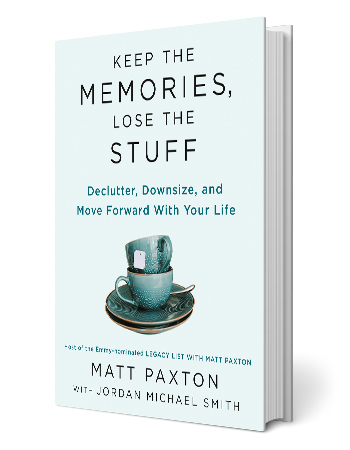Staying Fit


As host of the Emmy-nominated Legacy List With Matt Paxton on PBS and a featured cleaner on Hoarders, Matt Paxton has helped thousands of people from all walks of life declutter, downsize and live more simply. His new AARP book, Keep the Memories, Lose the Stuff, shares his unique, step-by-step process on the tools you need to get the job done.
In this AARP Members Only Access exclusive, members can read Step One — which Paxton calls the most crucial of the nine steps — for free, and start learning to let go of what no longer serves you, and identifying the items worth keeping so that you can focus on living the life you want.


AARP Membership— $12 for your first year when you sign up for Automatic Renewal
Get instant access to members-only products and hundreds of discounts, a free second membership, and a subscription to AARP the Magazine.
STEP ONE
**********
Uncover the Stories Behind the Stuff
DID CLEANING OUT DAD’S space spark an epiphany that decluttering is my lifelong purpose? Not at all. I was just happy to put off my job search for a few months while I figured things out. I still had no idea how I was going to earn a living. My father, my hero, was gone, and I was lost and wandering—and the only thing worse than being lost in life is being lost in life and broke.
I had one thing going for me, though: a community. People knew my grandfather, they knew my father, and now they knew me. I had my people. The upside of a tightly knit community is that people look out for you when you’re down on your luck. The downside is that everyone knows the details of your life. Both realities played into what happened next.
Word got around that I had cleared out my dad’s house and that I was looking for work. At church one Sunday, a kindly eighty-year-old woman—we’ll call her Etta—came over to me. I’d known her my entire life—she and her loving squad of bridge players, with their immaculate, blue-tinted white hair. No matter what was going on in their lives, these women got their hair done at the beauty parlor every other Thursday afternoon.
Etta told me she’d heard I was looking for some ways to make money and offered to help me out. She lived in an old colonial house like my father’s, and her friends were encouraging her to downsize now that her beloved husband, Jim, had died. She was years away from going into senior living, she hastened to inform me. But she figured I could use some extra money. She asked if I could do some work for her.
I quickly agreed, happy to help her out and earn some cash. A few days later, I arrived at her home ready to clear out what I assumed were a few boxes.
Then I stepped inside. Etta’s home was a sign of a well-lived life. Dishes and crystal of every type imaginable were stacked in her kitchen and dining room. Cases of wine and shelves of wineglasses. Linen tablecloths and napkins folded neatly. At least ten card tables and dozens of decks of cards. It looked to me like her home held enough to supply a banquet hall.
I had thought, going over to Etta’s home, that helping her declutter would be depressing. Weren’t we going to throw away a lifetime of stuff, after all? Wouldn’t helping her clean out be like helping her write her own obituary?
That wasn’t what happened at all. Over the next few weeks, Etta and I took pleasure in her favorite life stories. We didn’t bury her best years; we celebrated them. She had an eager audience in me, and she was in control of how the organizational process worked. She took her time. Etta’s memories were given another life when she recalled them to me—and in this chapter I’m giving them another life by recalling them to you. This is the most important part of the process—the part most experts miss entirely. If we don’t know the stories behind the stuff, we will never be able to freely let go of it.
If you are in the process of decluttering, downsizing, or moving, telling your stories to an interested audience is the magic key. And if you’re helping someone else, it’s your responsibility to listen. In this chapter, I’m going to show you how to both tell and listen to the tales.


































































You Might Also Like
How to Make Your Home Safer
Simple tips that can protect you and your loved ones — and may even save your life
Strategies to Declutter Your Home
Unsure what to purge? Follow these tips from expert organizers and clear your way to a happier space
Increase the Value of Your Home
From flooring to roofing, these upgrades can offer a great return on your investment — both now and in the future
More Members Only Access